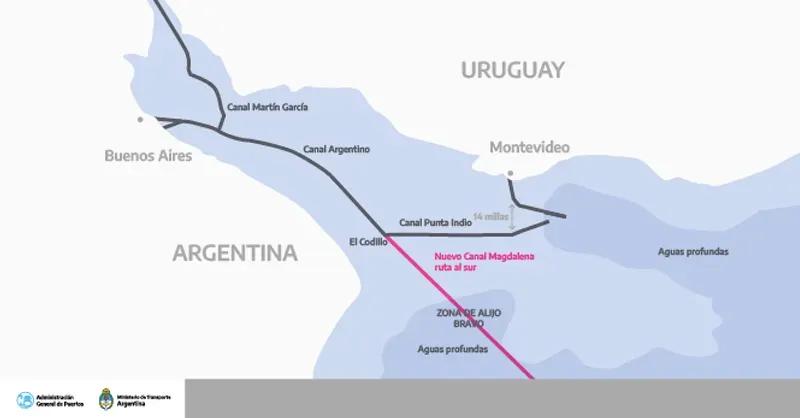Magdalena Channel Project
The Port of La Plata, of great strategic importance at the national level, is located in the Río de la Plata, from where the majority of fuel in Argentina is distributed, approximately 60% of what is exported.
This port is situated near the YPF refinery, which produces 70% of the fuel consumed by Argentina; it is mostly distributed from the Port of La Plata to the rest of the country (from Formosa to Ushuaia). In addition, it has the best conditions for ships circulating in international trade and is the main deep-water port in the country.
Currently, our port system has a significant inefficiency which is that the routes follow the natural course of the rivers until reaching the point of “El Codillo” (Punta de Indio height), where a diversion is made that leads traffic towards Uruguay, which considerably affects daily navigation. Today, the Punta Indio Canal is the only way in and out to the ports of the Río de la Plata, the Paraná River, and the Uruguay River, both for overseas vessels coming from Europe, Asia, or other parts of the world, and for vessels coming from the south of the country.
It is an artificial single-lane canal, 120 km long, 100 m wide, and 34 feet deep. It begins in the "Pontón Recalada" area, in front of the Port of Montevideo, and extends westward to “El Codillo” until it converges with the Intermediate Canal at km 121 of the Río de la Plata.
Due to its own conditions, a vessel intending to enter Argentine river ports via the Río de la Plata must anchor in a waiting area located in common waters of the Río de la Plata, whose traffic is managed by Uruguay, between Piriápolis and Montevideo. There, the vessels wait for the maritime authority of Uruguay, the Río de la Plata Traffic Control Center (CONTRASE), and the Argentine Naval Prefecture (PNA) to grant permission for entry.
Additionally, the canal presents the following characteristics: a) it is a narrow, single-lane canal, b) it does not have a straight trajectory, c) it presents excessive sedimentation rates, d) it does not follow the direction of the main currents, and e) it is not oriented in favor of the prevailing winds and waves in the river.
This generates consequences: it delays traffic, causes delays, inefficiencies, and increased costs (the delayed days are charged and must be paid by the national producer or consumer). Also, many large vessels that would encounter issues at El Codillo do not enter and remain at the Port of Montevideo, so Argentine producers have to transship from smaller vessels, increasing costs.
In light of the great relevance of the Port of La Plata and its inefficiencies, there is a need to create an accessible and efficient port and navigation system where the greatest amount of cargo possible can circulate, at low cost and in an agile manner, providing a beneficial response for our economy.
Therefore, considering that the main consumption and production of the country are concentrated in the centers of the provinces of Buenos Aires and Santa Fe, this system must facilitate the flow from this productive nucleus to the rest of the country and abroad. It is essential to take advantage of the almost total navigability of our rivers that reach the center of the continent (Bolivia), characterized by their flat territory, making it much more accessible and one of the few that exist under these conditions.
From this, the alternative of the Magdalena Canal arises, which would connect this port with other ports of the country’s node, thus reducing navigation costs and allowing access and navigation of larger ships, which would contribute to national economic activity. The Magdalena Canal is a navigation route that begins at progressive km 143,074; it extends from “El Codillo” to the south and currently has a draft of 15 feet and an approximate extension of 55 km. Its main challenge is depth, as it prevents larger vessels from using it as a route to access the river ports of the Río de la Plata, the Paraná River, and the Uruguay River; hence, dredging, deepening, and widening works need to be carried out so that it can be used as a navigation route for river transport.
The opportunities that this canal opens can be summarized as: providing direct access to the sea and improving river-maritime connectivity, connecting the Plata Basin with Antarctica without having to navigate through waters managed by another country, enjoying greater autonomy in our country’s foreign trade, saving time and logistical navigation costs, as well as the possibility of productive development and job creation both in seaports and in maritime and river transport.
In summary, the Magdalena Canal is a geopolitical, economic, sovereign, and developmental point that responds to national defense and sovereignty interests. That is why I consider it essential to continue betting on this alternative that serves Argentine development for and by the nation, defending our growth and autonomy.

Comments